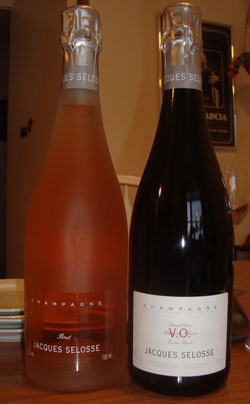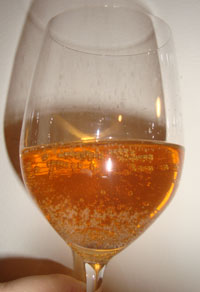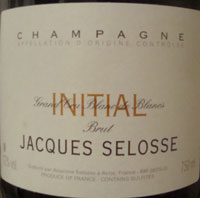Jacques Selosse Champagne
Some of the most Unique and Individualistic wine in Champagne
The charismatic, influential, and unorthodox Anselme Selosse has been running Jacques Selosse Champagne since 1980 and producing unique Grower wines with a cult-like following. If you get a chance to try one, do not think of it as Champagne or you may be confused. They are wines first; Champagnes second, and are phenomenal and sometimes profound, extremely organically made, and often a comparison to Burgundy is made for obvious reasons, both if you taste them and if you read on.
Also see notes from a Amazing Jacques Selosse tasting where I tasting a dozen of his wines, including his 6 single vineyard or Lieux-Dits!
Jacques Selosse and family started in the 1950s and their first bottling was in 1960. They own some fantastic Grand Cru vineyards in Ambonnay, Aÿ, Avize, Cramant, Oger, Le Mesnil, and Mareuil-sur-Aÿ, mostly Chardonnay, with about 7.5 hectares in total, and are officially a Grower-Producer releasing approximately 50,000 bottles a year.
Jacques' son Anselme studied winemaking in Burgundy at Lycée viticole de Beaune and joined his father at Jacques Selosse in 1974. When he took over in 1980, he implemented ideas that were considered outlandish in Champagne although some were certainly accepted in Burgundy. No surprise his wines are Burgundian, specifically White Burgundian with the preponderance of Chardonnay holdings. As a massive White Burgundy fan, I will be trying more of his wines!
One central idea is that great wines come from great terroirs and the quality of the fruit is critical. This idea is accepted doctrine in Burgundy, but in Champagne even today most wines are a blend that represents no particular terroir. Also there was no impetus for growers to produce quality fruit as they were not paid on quality, but on where the fruit was grown. (Note that I do not remotely claim that wines that do not represent a specific terroir cannot be profound, for example 1966, 1990 and 1996 Dom Perignon and 1990 Cristal to name just a very very few).
Alselme states that his wines are mostly viniculture, that it they are not made great through cellar practices.
Anselme also greatly reduced yields (he has some of the lowest around), uses a minimum of sulpher, only native yeasts, French oak in fermentation and aging along with a few Acacia barrels that he says add freshness), recommends decanting his wines, and not only embraces but is the leader in the biodynamic movement in Champagne (although he avoids the label "biodynamic" and feels free to do whatever is best). Malolactic fermentation may or may not occur; it is not blocked.
Biodynamic viticulture includes "far out new age" thoughts such as "ethical spiritual considerations" as well as more well adopted organic practices such as eschewing chemical fertilizers and pest control compounds. Biodynamic techniques include homeopathic applications of natural products often according to the phases of the moon and sun, and some of them are made by burying natural substances in cow horns and stag's bladders. Soils are worked by traditional old fashioned methods, such as as plowing and tilling. Some of the top Domains in France have gone 100% Biodynamic (e.g. Domaine Zind-Humbrecht, Domain Leroy, and Maison Chapoutier). Some absolutely kick-ass Champagnes are biodynamic, which besides Selosse, include Andre Beaufort, Larmandier-Bernier, and David Leclapart and some are moving towards full biodynamic like Ulysse Colin.
Selosse is no longer strictly biodynamic, although he was from 1996 to 2001, and eschews all labels and certifications. He is more concerned with the health of his vines and grapes and the quality of the wines he produces than being strictly "organic" or "biodynamic." For example, if he feels a non organic substance is beneficially, for example to combat mildew during a particularly wet growing season, he will use it.
I'll add a list of his wines as I drink them (got a few waiting for me!), and there are a dozen more tasting notes here: Amazing Jacques Selosse tasting.
 Tasting
Note" Jacques Selosse V.O. (Version Original) - Feb 2014,
disgorged 25 October 2010. Rated A
Tasting
Note" Jacques Selosse V.O. (Version Original) - Feb 2014,
disgorged 25 October 2010. Rated A
Version Originale is a blend of three vintages of Chardonnay from Avize, Oger and Cramant, just as like the Initial (Inital tasting notes here). The Initial is a blend from the mid-2000s and lower slope vines, while the Originale is made from older vintages and hillside vines.
A resounding pop immediately followed by odors of fresh bread amd the sound of crackling bubbles.
Rich midweight yellow color with a touch of orange.
The nose is initially a light, perhaps golden. apple. Apple peel after a few minutes.
On the palate, the term "fireworks in the mouth" comes to mins as it has before with Selosse. In general I find Selosse to be wonderfully balanced yet much more explosive on the palate.
Lipsmacking and incredibly long. Great harmony, creamy, almost milky finesse, with a slight orangeness.
Very few bubbles visible, yet it has the mouthfeel of thousands of bubbles! Very slight non obtrusive oxidation, a sometimes Selosse trademark.
 Tasting
Note: Jacques Selosse Rose - Feb 2014, disgorged 26 November
2010, rated A-. Maybe it deserves an A as the last sip, saved a couple
hours later, was the best!
Tasting
Note: Jacques Selosse Rose - Feb 2014, disgorged 26 November
2010, rated A-. Maybe it deserves an A as the last sip, saved a couple
hours later, was the best!
Selosse only makes 6000 bottles a year of his Rose and this is the only bottle I've ever seen. Made from two successive vintages and primrily Avize Chardonnay with some still Pinot Noir from Ambonnay.
A bold copper on color.
The nose had strawberry flowers, perhaps geraniums, a liitle orange, and roses. A little almond or apricot pit type nose and freshly laundered cotton.
This kept getter bigger and more intense with time, yet not nearly as big as the V.O. above. A melange of tropical fruits - pretty sild. A spicyness, almost menthol, after hours of air.
A wonderful inner warmth and glow that transcends word!
 Tasting
Note: Jacques Selosse Initial Blanc de Blancs Brut -
Nov, 2012. Disgorged 20
October 2010. I'm not sure I'm qualified to rate this wine, but I'll give
it an A-
Tasting
Note: Jacques Selosse Initial Blanc de Blancs Brut -
Nov, 2012. Disgorged 20
October 2010. I'm not sure I'm qualified to rate this wine, but I'll give
it an A-
This is made from Grand Crus in Avize, Cramant, and Oger, and from 3 successive vintages according to the label.
A light to medium golden yellow color with plenty of bubbles (I'll go further and use the vernacular to say a "shit load" of bubbles and fizz).
The nose is initially green apple with a spicy minerality, and a minty-ness exactly like I get on young Corton Charlemagnes (among my favorite White Burgundies). With air, a mélange of chalk and minerals I could smell forever. Even an empty glass has a wonderful smell, and the empty glass even smells nice 24 hours later.
The palate is simply wild. It starts with slight oxidation, is very mouthfilling and vinuous, and has green apple similar to the nose. The plate is not nearly as enticing as the nose initially, but as it warms and breathes, a creamy foaminess, like an orange creamsicle, with orange citrus rind for sure.
The last sip was the best.
Next time, I'll let this warm more before drinking and decant as well!
